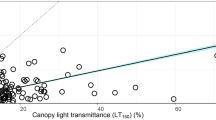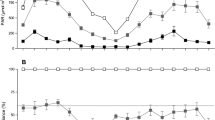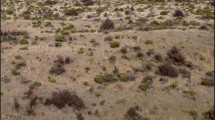Abstract
Ecuadorian mountain rainforests are declining dramatically due to deforestation. Exploitation of remaining forests has led to low abundances of native, valuable timber species. Enrichment planting of selected native tree species into forest gaps is a strategy that may increase their abundance and maintain biodiversity. However, the development of successful planting strategies requires knowledge of environmental demands on, and ecological requirements of, native species during their establishment. This knowledge is currently lacking for mid- and late-successional species in Central American forests. Two deciduous, mid-successional (Cedrela montana, Tabebuia chrysantha) and two evergreen, late-successional native tree species (Nectandra membranacea, Podocarpus sprucei) were planted into felling gaps. Photosynthetic performance and growth in height of these species were assessed along light gradients during seedling establishment to test whether species-specific light responses were related to plant successional traits. Both mid-successional species benefited from higher light levels in gaps up to 30% canopy openness60°. In larger gaps, C. montana exhibited a significant decline in growth. As expected, growth of the late-successional species was only marginally increased at higher light levels. Nevertheless, the photosynthetic apparatus of N. membranacea displayed rapid acclimation to higher light conditions in gaps. Plant response to felling gaps may not always be predicted based on successional status. Our results suggest that the four investigated species may coexist in the same gap by occupying different niches along light gradients. This arrangement may offer an ecological basis to increase the abundance of valuable timber species through enrichment planting in Ecuador mountain rainforests.







Similar content being viewed by others
References
Aguirre N, Günter S, Weber M, Stimm B (2006) Enrichment of Pinus patula plantations with native species in southern Ecuador. Lyonia 10:33–45
Bader MY, van Geloof I, Rietkerk M (2007) High solar radiation hinders tree regeneration above the alpine tree line in northern Ecuador. Plant Ecol 191:33–45
Balslev H, Øllgard B (2002) Mapa de vegetación del sur de Ecuador. In: Aguirre M, Madsen Z, Cotton JE, Balslev H (eds) Botánica Austroecuatoriana. Estudios sobre los recursos vegetales en las provincias de El Oro, Loja y Zamora-Chinchipe. Ediciones Abya-Yala, Quito, pp 51–64
Barberis IM, Tanner EVJ (2005) Gaps and root trenching increase tree seedling growth in Panamanian semi-evergreen forest. Ecology 86:667–674
Barker MG, Press MC, Brown ND (1997) Photosynthetic characteristics of dipterocarp seedlings in three tropical rain forest light environments: a basis for niche partitioning? Oecologia 112:453–463
Bazzaz FA, Carlson RW (1982) Photosynthetic acclimation to variability in the light environment of early and late successional plants. Oecologia 54:313–316
Beck EH, Kottke IL (2008) Facing a hot spot of tropical biodiversity. Basic Appl Ecol 9:1–3
Bendix J, Homeier J, Cueva Ortis E, Emck P, Breckle SW, Richter M, Beck E (2006) Seasonality of weather and tree phenology in a tropical evergreen mountain rain forest. International J Biometerol (online first)
Brokaw NVL (1985) Gap-phase regeneration in a tropical forest. Ecology 66:682–687
Brummit N, Lughada EN (2003) Biodiversity: where’s hot and where’s not. Conserv Biol 17:1442–1448
Bussmann RW (2006) La diversidad florística andina y su importancia por la diversidad cultural – ejemplos del Norte de Perú y Sur de Ecuador (Andean floristic diversity and ist importance for cultural diversity – examples from Northern Peru and Southern Ecuador). Lyonia 10
Cabrera Cisneros O, Günter S, Mosandl R (2006) Dynamics in natural and selectively logged tropical mountain rain forest in south Ecuador. Lyonia 10:87–97
Carpentier CL, Vosti SA, Witcover J (2000) Intensified production systems on western Brazilian Amazon settlement farms: could they save the forest? Agric Ecosyst Environ 82:73–88
Castillo M, Cueva D, Aguirre N, Günter S (2007) Propagación vegetativa de dos especies de Podocarpaceas. Bosques Latitud Cero 2:3–5
Chazdon RL (1988) Sunflecks and their importance to forest understorey plants. Adv Ecol Res 18:1–63
Coomes DA, Grubb PJ (2000) Impacts of root competition in forests and woodlands: a theoretical framework and review of experiments. Ecol Monogr 70:171–207
Denslow JS (1980) Gap partitioning among tropical rainforest trees. Biotropica 12:47–55
Eckert T (2006) Biomasseuntersuchung an jungen Aufforstungspflanzen von Cedrela montana und Tabebuia chrysantha in Süd-Ecuador. Waldbau, vol Diplom. TU München, Freising
Englund SR, O’Brien JJ, Clark DB (2000) Evaluation of digital and film hemispherical photography and spherical densiometry for measuring forest light environments. Can J For Res 30:1995–2005
Galvez JR, Ordonez G, Bussmann RW (2003) Estructura del bosque montano perturbado y noperturbado en el Sur de Ecuador Structure of disturbed and undisturbed mountain forests in southern Ecuador. Lyonia 3:83–98
Grams TEE, Anegg S, Haeberle K-H, Langbartels C, Matyssek R (1999) Interactions of chronic exposure to elevated CO2 and O3 levels in the photosynthetic light and dark reactions of European beech (Fagus sylvatica). New Phytol 144:95–107
Günter S (2009) Tabebuia chrysantha (Jacq.) Nichols. 1887. In: Roloff A, H W, Lang U, Stimm B (eds) Enzyklopädie der Holzgewächse, vol. Wiley–VCH, Weilheim (in press)
Günter S, Mosandl R (2003) Nachhaltige Naturwaldbewirtschaftung in Bergregenwäldern Südecuadors. Waldbau weltweit–Beiträge zur internationalen Waldbauforschung. Waldbau weltweit–Beiträge zur internationalen Waldbauforschung, vol 192. Forstl. Forschungsber, München
Günter S, Cabrera Cisnos O, Weber M, Stimm B, Zimmermann M, Fiedler K, Knuth J, Boy J, Iost S, Wilcke W, Makeshin F, Werner F, Gradstein SR, Mosandl R (2008a) Natural forest management in neotropical mountain rain forests—an ecological experiment. In: Beck EBJ, Kottke I, Makeschin F, Mosandl R (eds) Gradients in a tropical mountain ecosystem of Ecuador, vol 198. Springer, Berlin
Günter S, Stimm B, Cabrera M, Diaz ML, Lojan M, Ordonez E, Richter M, Weber M (2008b) Tree phenology in montane forests of southern Ecuador can be explained by precipitation, radiation and photoperiodic control. J Trop Ecol 24:247–258
Günter S, Gonzales P, Alvarez G, Aguirre N, Palomeque X, Haubrich F, Weber M (2009) Determinants for successful reforestation of abandoned pastures in the Andes: soil conditions and vegetation cover. For Ecol Manage 258:81–91
Gyimah R, Nakao T (2007) Early growth and photosynthetic responses to light in seedlings of three tropical species differing in successional strategies. New For 33:217–236
Hartig K, Beck E (2003) The bracken fern (Pteridium aquilinum) dilemma in the Andes of south Ecuador. Ecotropica 9
Henderson A, Churchill SAP, Luteyn JL (2003) Neotropical plant diversity. Nature 351:21–22
Herms DA, Mattson WJ (1992) The dilemma of plants—to grow or defend? Q Rev Biol 67:283–335
Hofstede RGM, Groenendijk JP, Coppus R, Fehse JC, Sevink J (2002) Impact of pine plantations on soils and vegetation in the Ecuadorian High Andes. Mt Res Dev 22:159–167
Homeier J (2008) The influence of topography on forest structure and regeneration dynamics in an Ecuadorian montane forest. In: Gradstein SR, Homeier J, Gansert D (eds) The tropical mountain forest—patterns and process in a biodiversity hot spot, vol 2. University of Göttingen, Göttingen, pp 97–108
Homeier J, Dalitz H, Breckle SW (2002) Waldstruktur und Baumartendiversität im montanen Regenwald der Estación Científica San Francisco in Südecuador. Berichte der Reinhold-Tüxen-Gesellschaft 14:109–118
Houter NC, Pons TL (2005) Gap size effects on photoinhibition in understorey saplings in tropical rainforest. Plant Ecol 179:43–51
Kobe RK (1999) Light gradient partitioning among tropical tree species through differential seedling mortality and growth. Ecology 80:187–201
Kurokawa H, Kitahashi Y, Koike T, Lai J, Nakashizuka T (2004) Allocation to defense or growth in dipterocarp forest seedlings in Borneo. Oecologia 140:261–270
Kursar TA, Coley PD (1999) Contrasting modes of light acclimation in two species of the rainforest understory. Oecologia 121:489–498
Lamprecht H (1986) Waldbau in den Tropen. Parey, Berlin
Langenheim JH, Osmond CB, Brooks A, Ferrar PJ (1984) Photosynthetic responses to light in seedlings of selected Amazonian and Australian rainforest tree species. Oecologia 63:215–224
Lhotka JM, Loewenstein EF (2006) Indirect measures for characterizing light along a gradient of mixed-hardwood riparian forest canopy structures. For Ecol Manage 226:310–318
Mitamura M, Yamamura Y, Nakano T (2009) Large-scale canopy opening causes decreased photosynthesis in the saplings of shade-tolerant conifer, Abies veitchii. Tree Physiol 29:137–145
Mohammed GH, Parker WC (1999) Photosynthetic acclimation in eastern hemlock [Tsuga canadensis (L.) Carr.] seedlings following transfer of shade-grown seedlings to high light. Trees Struct Funct 13:117–124
Montagnini F, Jordan CF (2005) Tropical forest ecology—the basis for conservation and management. Springer, Berlin
Montagnini F, Eibl B, Grance L, Maiocco D, Nozzi D (1997) Enrichment planting in overexploited subtropical forests of the Paranaense region of Misiones, Argentina. For Ecol Manage 99:237–246
Montgomery RA, Chazdon RL (2002) Light gradient partitioning by tropical tree seedlings in the absence of canopy gaps. Oecologia 131:165–174
Mosandl R, Günter S, Stimm B, Weber M (2008) Ecuador suffers the highest deforestation rate in South America. In: Beck EBJ, Kottke I, Makeschin F, Mosandl R (eds) Gradients in a tropical mountain ecosystem of Ecuador. Springer, Berlin, pp 37–40
Myers GP, Newton AC, Melgarejo OJ (2000) The influence of canopy gap size on natural regeneration of Brazil nut (Bertholletia excels) in Bolivia. For Ecol Manage 127:119–128
Paulsch A, Schneider R, Hartig K (2001) Land-use induced vegetation structure in a montane region of southern Ecuador. Die Erde 132:93–102
Pichón FJ (1996) The forest conversion process: a discussion of the sustainability of predominant land uses associated with frontier expansion in the Amazon. Agric Human Values 13:32–51
Piotto D (2007) Growth of native tree species planted in open pasture, young secondary forest and mature forest in humid tropical Costa Rica. J Trop For Sci 19:92–102
Poorter L, Arets EJMM (2003) Light environment and tree strategies in a Bolivian tropical moist forest: an evaluation of the light partitioning hypothesis. Plant Ecol 166:295–306
Poorter L, Hayashida-Oliver Y (2000) Effects of seasonal drought on gap and understorey seedlings in a Bolivian moist forest. J Trop Ecol 16:481–498
Ramos JM, Delamo S (1992) Enrichment planting in a tropical secondary forest in Veracruz, Mexico. For Ecol Manage 54:289–304
Rich PM, Clark DB, Clark DA, Oberbauer SF (1993) Long-term study of solar-radiation regimes in a tropical wet forest using quantum sensors and hemispherical photography. Agric For Meteorol 65:107–127
Schnitzer SA, Kuzee ME, Bongers F (2005) Disentangling above- and below-ground competition between lianas and trees in a tropical forest. J Ecol 93:1115–1125
Schrumpf M, Guggenberger G, Schubert C, Valarenzo C, Zech W (2001) Tropical montane rain forest soils—development and nutrient status along an altitudinal gradient in the south Ecuadorian Andes. Die Erde 132:43–59
Shipley B (2006) Net assimilation rate, specific leaf area and leaf mass ratio: which is most closely correlated with relative growth rate? A meta-analysis. Funct Ecol 20:565–574
Svenning JC, Fabbro T, Wright SJ (2008) Seedling interactions in a tropical forest in Panama. Oecologia 155:143–150
Tanner EVJ, Barberis IM (2007) Trenching increased growth, and irrigation increased survival of tree seedlings in the understorey of a semi-evergreen rain forest in Panama. J Trop Ecol 23:257–268
Trichon V, Walter J-NM, Laumonier Y (1998) Identifying spatial patterns in the tropical rain forest structure using hemispherical photography. Plant Ecol 137:227–244
Valencia R, Ceron C, Palacios W, Sierra R (1999) Las formaciones naturales de la sierra del Ecuador. In: Sierra R (ed) Propuesta preliminar de un sistema de clasificación de vegetación para el Ecuador continental. Proyecto INEFAN/GEF-BIRF y EcoCiencia, Quito, pp 79–108
Van der Meer PJ, Dignan P, Saveneh AG (1999) Effect of gap size on seedling establishment, growth and survival at three years in Mountain Ash (Eucalyptus regnans F.Muell.) forest in Victoria. For Ecol Manage 117:33–42
Weber M, Günter S, Aguirre N, Stimm B, Mosandl R (2008) Reforestation of abandoned pastures: silvicultural means to accelerate forest recovery and biodiversity. In: BJ Beck E, Kottke I, Makeschin F, Mosandl R (eds) Gradients in a tropical mountain ecosystem of Ecuador. Springer, Berlin, pp 447–458
Wilke W, Yasin S, Schmitt A, Valarezo C, Zech C (2008) Soils. In: Beck E, Bendix J, Kottke I, Makeschin F, Mosandl R (eds) Ecological studies 198—gradients in a tropical mountain ecosystem of Ecuador. Springer, Berlin
Wunder S (2000) The economics of deforestation: the example of Ecuador. Macmillan Press, London
Acknowledgments
This study was financed by the German Research Foundation (DFG), Kennedy Allee 40, 53175 Bonn. We thank Dominik Farnaday and Jonas Hönnebeck for help with the field work. Dr. Nancy Grulke is thanked for help with the English text. This study would not have been possible without the management of the planting activities by Nicolay Aguirre and the seedling cultivation in the tree nursery of the DFG at the Universidad National de Loja.
Author information
Authors and Affiliations
Corresponding author
Additional information
Communicated by C. Lovelock.
Rights and permissions
About this article
Cite this article
Kuptz, D., Grams, T.E.E. & Günter, S. Light acclimation of four native tree species in felling gaps within a tropical mountain rainforest. Trees 24, 117–127 (2010). https://doi.org/10.1007/s00468-009-0385-1
Received:
Revised:
Accepted:
Published:
Issue Date:
DOI: https://doi.org/10.1007/s00468-009-0385-1




